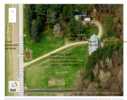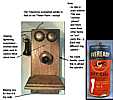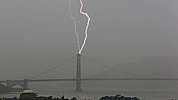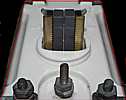Goode Ole Dayze
|
This section is about rural life before gasoline tractors and modern agricultural automation. About 1/2 of the
people in the U.S. were directly or indirectly involved with growing food for themselves and the other 1/2.
Power was human labor and draft animals. No air conditioned tractors with farmers rarely touching the "product".
Mitch provided the fascinating pictures of rural Colorado below,
Added by Ed Thelen since -
|
from Mitch Allies - mrallies @ sbcglobal . net
September 2010
|
When there was no Social Security ---
These are all pictures of my mother's aunt and uncle.
|
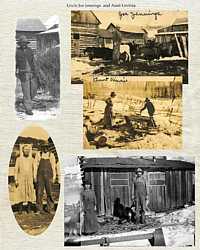 click for 160 KB |
The following 4 pictures were taken near Telluride, Colo. circa 1915.
-- In the livestock corral, Joe was very proud of his white mule that you can see standing there.

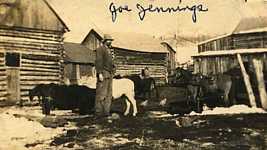
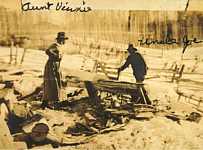
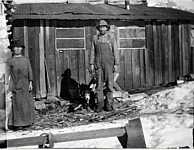
The following 2 pictures were taken at Cerro Summit - about 10 miles from Montrose - circa 1930.

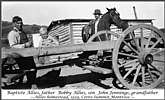
More images
| The barn we built. | 
| The horse "ole Buck" was a buckskin as you can see. He was considered ideal for trapping because you could transport bobcat pelts without him getting spooked. | 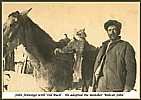
|
The following comments flowed back and forth
- Ed Thelen to Mitch Allies
- Mitch Allies back to Ed Thelen
I'm not sure "my audience" is ready
for this dose of "the good ole daize".
I mean
- no color TV - not even black&white
- no Internet, on-line movies, e-mail, ...
- no phone - let alone cell phone with camera -
- no government provided transportation to the dentist
- in a motor car no less -
- no air conditioning or gas furnace with thermostat
- no city water, sewer, gas, electric, daily newspaper, ...
-- like your own or neighborhood well, w bucket
-- your own Out House, or throw the "slops" into the street
-- wood or coal fire for cooking
--- the wealthy could afford fire places for heat
- no Chinese made clothes, too inexpensive to be worth
re-soleing or mending
Just lots of work and inconvenience
like the subjects had to stand still
for the photo - or look smeary
And for real -
not a "rural" painting of some city folk
looking serious, in front of a barn -
Too difficult to bridge the gap -
One political party would want to take credit
for all the "progress" since ;-))
Or maybe both -
- one claiming "social services"
- one claiming inventiveness and production
I've reduced the file size (and resolution)
since my eldest son has chosen to be "deprived"
staying with "dial-up" of pre-year 2000
Like how primitive can you get ??
Maybe he doesn't have a flush toilet??
or take showers??
or have an electric car
- powered by coal/oil fired generators -
or a "hydrogen" car, powered by the same
I bet those old folks felt more secure than
many of our old folks,
ours being fearful of
- thugs and robberies
- dying alone and not being missed for weeks
- starving, since they have no garden nor chickens
Ed ( who remembers old rural folks in Wisconsin ) Thelen
Yeah, I enjoyed your commentary, so- should I add?
Economies of scale are great - can almost reduce prices to cost of raw stuff
You could probably comment that the existence of these pictures is
attributable to Kodak economies of scale.
-However, they reduce individuality significantly,
-You previously could get a pretty good idea of a man by examining his pocket contents.
-Now you find generic credit cards and cell phones.
-A few years back - a body in Paris with Greek coins in the pocket
-Was likely Greek
-Now he has Euros, and is European.
The next frontier will be spoken and written language-
No more need to puzzle Hieroglyphics .
and of course the Final Frontier already defined by Watson and Crick
My father used to tell a tale on himself -
He grew up on a farm, serious extended hard labor -
(Much too cruel and unusual for our prisoners.)
Being tired of the above he looked for a place to hide -
(I guess his usual haunts were too known.)
So he climbed up the ladder on the windmill,
curled up on the little working platform,
and dozed off -
A breeze came up, from a wrong direction,
the mill assembly and blades rotated,
knocking him off the platform.
He must have been young and very lucky
only breaking an arm !!
He was taken to the town doctor in a (horse drawn) farm wagon.
The town doctor did a poor job
having to break the arm and reset it properly later.
|
- Ed Thelen to Mitch Allies to Ed Thelen - Jan 12, 2012
|
Ed forwarded a whacky photo
REAL COWBOYS HAVE NO FEAR 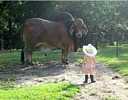
click to enlarge
Mitch came back with: Brahmas -- I think they came from India way back somewhere. Surprisingly they are not aggressive in a notorious way. -- never saw them much back home, except maybe at a rodeo Story from my Mom---------- She said she wasn't ever going to allow Jersey bulls on our farm. At some later date she told the rest of the story. When my sisters were little she began working for a guy name Ferguson on a ranch east of town. She did all the inside duties. My Dad was gone in the summers herding sheep out near Swinging Bridge, Utah. Ultimately they bought the Farm from Ferguson and it became our home. The reason Ferguson needed housework was because his wife had been trying to cross one of the lower pastures where some Jersey bulls resided. Apparently they have a nasty temperament, and one of them took after her and gored her so severely that it was fatal.
--------------
|
Why is the sun so hot? - Added June 9, 2012 -
|
When I was young and throughout my college days, my family raised sheep, maybe 300 head as our primary source of income. During summertime we grazed the herd on a section of land in the high country near Montrose, CO. This size of herd was not large enough to mandate a herder - so we would visit the grazing area every few days to make sure the herd had not strayed onto the county road or met with a wayward coyote.
Now, you have to understand that my dad had only a 3rd grade education, and those years had been rendered difficult by a bunch of obdurate nuns intent upon teaching everything in French, regardless of the native tongue of the students. (Seems a little like today!) One day in my senior year of college physics (perhaps it was spring break) we had finished verifying that the sheep were OK in the grazing section, and I was driving us back the 7 miles home at about sunset. Dad was always taciturn, but he came out with this question "I wonder what makes that old sun so hot?" Having touched that subject in my recent education, I jumped into the breach and spent about four sentences explaining a fusion chain that started with hydrogen and could produce elements as heavy as iron and lots of heat.
As I paused thinking I probably covered it, Dad looked toward me driving and said "They don't know!". The trip continued with the normal taciturn silence. During that silence I had some thoughts ---
I should say (of dad) that his final 3rd grade year was 1901, four years before special relativity; many things were unknown then.
|
Chamber Pots, Outhouses Etc - by Ed Thelen - Sept 30, 2012
|
Reference:
- The Great Stink - biology out of "control" ;-)) - Out House - info for young folks, you tip over other people's on Halloween ;-)) - Chamber Pot - for the Guest Room, and cold (snowy) weather - CessPool or septic tank - if you had indoor plumbing :-)) but no city sewer :-((
Background:
In Minnesota & Wisconsin etc., there are advantages to
an indoor flush toilet rather than an out house.
Not so obvious to folks living in heavenly California
- no mosquitoes and flies in the summer
- and sitting on a wooden seat
with your bare butt at a windy -20 degrees
is not the kind of thrill you look forward to -
OK - so folks had "chamber pots"
for those not wishing to visit the "out-house",
but a view and whiff of a whole family's night excreta
drives even low brow me out doors !!!
Ya take the lid off the chamber pot,
drop your pans, and squat over the pot,
hoping to hell you don't miss, or have diarrhea
and examine and smell the poo of the previous users.
And a kid's morning chore of dumping that mess
into the out-house
was enough to ruin a hungry person's breakfast appetite !!
Our family, being city slickers in the winter,
did not have the chilly-butt, chamber-pot problem.
I learned about chilly-butt living with the Jansky's
at the Ferdig, Montana oil field,
and at the Army Nike site in Chicago -
Ed ( AH - the good olde dayze, I can smell 'em now :-))) Thelen
|
Charles Dickens comments on a London problem - from Mitch Allies Oct. 2012
THE NIGHT-SOIL MENAbove the river, in the streets of the city, the pure-finders eked out a living by collecting dog shit (colloquially called "pure") while the bone-pickers foraged for carcasses of any stripe. Below ground, in the cramped but growing network of tunnels beneath London's streets, the sewer-hunters slogged through the flowing waste of the metropolis. Every few months, an unusually dense pocket of methane gas would be ignited by one of their kerosene lamps and the hapless soul would be incinerated twenty feet below ground, in a river of raw sewage. The scavengers, in other words, lived in a world of excrement and death. Dickens began his last great novel, Our Mutual Friend, with a father-daughter team of toshers stumbling across a corpse floating in the Thames, whose coins they solemnly pocket. "What world does a dead man belong to?" the father asks rhetorically, when chided by a fellow tosher for stealing from a corpse. ""Tother world. What world does money belong to% This world:' Dickens' unspoken point is that the two worlds, the Bead and the living, have begun to coexist in these marginal spaces. The bustling commerce of the great ... |
Making Butter - added Feb 22, 2013
Making Butterfrom USAF-RadarStationVeterans@yahoogroups.comnewest near top - Posted by: "Fitz, Chief Fitz, Chief" chieffitz1935
"Leon" wrote:
"Dave" wrote:
Robert Smith wrote:
|
Entertainment - added Feb 23, 2013
Entertainmentfrom USAF-RadarStationVeterans@yahoogroups.composted by Bob Smith
To all my RSV Companions.
Monday thru Friday were school days and before and after school, the work of milking cows, feeding hogs and piglets, and tending to flocks of chickens, sopped up those precious few hours left in the day. No school on Saturdays but it was probably the busiest day of all for a young farm kid. Everything that couldn't be done before and after school during the week, had to be done on Saturday, this included cleaning out the chicken houses, cleaning out the hog pens and cow barn, filling up the hay mow with hay, fixing barb wire fences, digging new post holes, painting any out-buildings so they would not start looking dilapidated, cutting and splitting a weeks supply of kitchen fire wood, cleaning out the ashes of the kitchen stove plus basement furnace, opening the heavy door on the root cellar and bringing Mom all required vegetables for the weeks meals, plus any quart jars of canned pears, peaches, apricots she might want. However Sundays was a day of less work and more play. Unfortunately Dad was pretty much an atheist so we didn't establish a strong church going habit, so Mom would read to my Sister and I from the Bible. Quite often on Sunday afternoons we would invite our neighbors, the Cisneys, to come across the field to visit and play Dominoes or other table games. Their youngest boy (still 6 yrs older than me) could play the harmonica beautifully. Dad would relent from his constant desire to listen to the war news over and over on the radio, and let everyone listen to some of the truly great bands and music of the war time era. My dear Sister, though just a young tot, learned to play an accordion very well by the time she was 10 yrs old and also entertained everyone. For beverages we would all enjoy homemade apple cider and Mom would make fudge or popcorn. So we all had a great time. Even on Sunday, there was still chores like milking our cows, and feeding the pigs and chickens but for some reason it didn't seem so hard to do. Sometimes there would be a movies of interest come to the local theater. The only way we could possibly see it if was presented on a Sunday afternoon matinee, it would be over in plenty of time for the afternoon milking. I especially liked those wartime "propaganda" movies like "Guadalcanal Diary", "Flying Tigers", and "Air Force", the Fox Movietone newsreels were always exciting. It was the only way to see actual fighting scenes from all the theaters of war. Admission was 20 cents for kids. So entertainment on a farm was always available in some form or another. I never felt short - changed one bit. |
Making Wood Ash Soap - added Mar 25, 2013
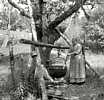 We have all read of our early pioneers making soap --- I personally have not heard (yet) any one
claim an ancestor made soap, but here is a picture from
"Shorpy.com" Jud McCarthy sent.
Note the very bleached stirring stick. ;-))
We have all read of our early pioneers making soap --- I personally have not heard (yet) any one
claim an ancestor made soap, but here is a picture from
"Shorpy.com" Jud McCarthy sent.
Note the very bleached stirring stick. ;-))
Now, about the general instructions for leaching (potassium) hydroxide from wood ashes and recipe using the hydroxide residue and lard (from cattle or pigs) for soap making - This web site seems realistic :-| |
The Daily Morning Shower, we take for granted - added Aug 23, 2013
|
by Ed Thelen
I did a major upgrade to the filter of the koi pond - removing 3 below ground surface "cyclone" tanks of 3.5 ft. diameter, lots or re-piping, filling the 5x5x15 foot hole - and banged up my shins - which formed scabs. Taking my daily shower caused the scabs irritation - so I stopped showering. The wife reminded me that I don't smell "like a rose". So I remembered the farm and Saturday night baths in the laundry tub :-(( The summer before Pearl Harbor, we got the following installed in the farm house, the down sides were So, we could take comfortable baths any time we wanted - not the struggles and discomfort of sitting in the laundry tub, getting colder, in the middle of the kitchen near the stove heating water. After mother and dad had their baths, we kids got to dump the water and put in fresh for us. ................. |
Horse Sense – They weren't the Clydesdales - added Sept 27, 2013
Horse Sense – They weren't the Clydesdales
To Karen & Melanie (animal persons)
My memories began to appear as fuzzy pieces of a puzzle sometime around the age of 4 or 5 years. Post war America was settling in , but all that I remember was a family consisting of two parents that were 50 years my senior and three teenage sisters that were quite nice, but didn't usually share my interests and curiosities. (Later I would learn that the teen years took much mental energy to survive the daily social requirements at school or home. But I was oblivious at 5.) My daily life was populated with animals, machinery, and plants. The plants on a farm mean physical labor of some type – planting, digging, harvesting, spraying; and completing the job at hand trumps interesting topics like plant biology, starting seedlings, and grafting. Crops or weeds equal “labor”, pure and simple. Animals however can become part of your life's memories, because they have simple personalities. Dad had a small cadre of work horses that we kept around for the tasks of farming. (The first tractor was purchased for the farm when I was 11). So, I came to know these beasts of burden from daily tasks of life, and from occasionally taking the reins of the more predictable teams. Pictures – People who own workhorses rarely take pictures of them – sad to say – so here are my pictures.
Nick:
Queen:
Prince:
Tom:
Tony: Tony was much the same Bay color as Queen but he may have had a stroke of white between his eyes ( I can't remember clearly.). The thing that set Tony apart was that he was smaller boned than the other horses, but still well muscled. In the corral he looked like a middleweight fighter standing among a group of heavyweights.
Cate:
King:
---------- Dad wanted no animal on the farm to become a pet or be petted, so I came to know the horses by observing them, or working by their side in the daily tasks. The closest I ever got to a personal relationship was either bringing the hay to them, a stroke on their forehead, or maybe lifting up a hoof to examine a place where it was splitting. ~~~~~~~~~~~ Teams were the byword for nearly all work at the ranch. Nearly all farm machinery by the 1930s was designed on the assumption that two or more horses would pull it. Only in a great many tasks did Dad harness a single horse. This fact of life necessitates the choice of pairs among the workhorses. The first pair I remember from tasks was Nick-Queen. They were very good at pacing themselves till the next watering and feeding and not excitable. With this team, you were not going to get there fast, but you would get there without problems. When Dad wanted to get these two up to a trot, he had to use a lot of rein slapping and verbal encouragement; and even with that, Queen resumed a walk after about 15 yards. Hay and grain harvesting can often be completed more quickly with two teams (for example) to pull two hayslips rather than using one hayslip. Therefore, a second team was selected, and this was Prince and “__”. Prince had the misfortune that the second name was either Tom or Tony. Tom, I noticed had the funny personal attribute that any utterance or movement from a human made him immediately look at the human. When he was harnessed beside Prince he was always on the right, which meant that any rein activity or words from Dad caused him to look over his left shoulder - even with the blinders. Prince was usually responsive at a quick walking gait, but Tom, because of his bent head often skewed the harness and didn't always move straight ahead, or make a “nice” turn. This behavior also occasionally created a slight stumble for Tom himself. Dad always drove this team to leave the consistent pullers for the others in the hayfield – and the wrestling match with Tom would go on for half the day. One day when it looked like Dad wasn't too irritated, I ask him why Tom did this awkward thing all the time. He said “I believe before I got him he was mistreated and beaten while he was in the harness, so now he is always trying to keep an eye on you. It ruined him.” Thus in this case Prince had a paranoid partner. (I had not guessed that on my own.)
The exciting times came when Prince and Tony had a light load like an empty hayslip – which is similar to a large wood snow sled. Dad would click to the team (special sound from the cheek of your mouth) and Tony was off with a hard lunge at the traces. Static friction was gone and Tony would break into a trot and Prince had no choice but to try to imitate his speed. In the next ten yards starting into the field Tony's speed increased to a canter. Dad would start yelling at them and reining back so that the slip could be stopped at the appropriate shock and not far past it. Sometimes, when the hay-shocks were at the other end of the field, Dad would let Tony have full rein. Sometimes there was only one load of hay left (yeah) and I would climb on the slip to help Dad with the final load. Dad had the reins to clutch, but since I was standing alone, I learned that the best position was with my feet apart and positioned diagonally to the square shape of the hayslip. In that position I was least likely to be upended. At the exit from the stackyard into the field, was a dip produced by installation of a water culvert. Late in the summer when the stackyard had three haystacks, the approach to the exit was lengthy enough for Tony to have enough steam to give you a small “whoohoo” as the slip moved over the dip. Shortly now, you were in the field, and the green hay-stubble would grease the runners on the hayslip. Tony had moved from a trot to a canter and was bordering a gallop. Now I could sense the breeze on by face and the acceleration was slowing so I could relax my leg muscles; although I remained in the Cassius Clay stance because the hayslip would sometimes fishtail from furrow to furrow. As sure as snow in the winter and quarter horse bloodlines, at about three-fourths the distance to the hay-shocks, Tony came to a dead stop, and Prince necessarily did also. Dad and I tried not to be thrown too far forward. So there he was nostrils flared, drawing in great gushes of air; and Dad usually allowed them 15 seconds of breathing before proceeding – now at the normal winded quarter horse walk. So, Tony was the speed daemon and Prince had two exasperating partners with which to deal. I asked Dad about Tony's running once and he just said that Tony liked to run. Dad was usually not inclined to providing background information. I also asked about the name “Tony” once. It sounded Italian, and I knew there were no Italians in the family. This time, less taciturn, he said, “His name wasn't really Tony; it was Tunney. He was named for that prize fighter that fought a few years ago.” I think that he probably was given that name during the attempts to break him for the saddle. ~~~~~~~~~~~~ Mom had to be patient and insistent to get some of the amenities she wanted at her house. One of the things she wanted was grass in the yard area because it provided great cleanliness in both winter and summer and underneath the clothes line. The grass appeared when I was young and by age 9 or 10 a Sears rotary mower. One morning I arose, and after shuffling around the kitchen a bit, I noticed that Mom seemed particularly agitated so I asked about the reason. “Oh!” she exclaimed, “Those darn horses got out of the corral last night and opened the yard gate and stomped around all over the lawn. They made this awful mess of the lawn.” She blamed Nick for the incident. Apparently, Nick was sometimes responsible for things going bump in the night. She told me that some years before when there was no lawn, a similar incident had occurred where Nick had managed (with his mouth) to turn on the spigot in the yard that was our sole supply of potable water. Horses don't turn off spigots, though, so by sunrise, it created a large mud area around the wood platform next to the spigot. I launched my own minor investigation after I got some shoes on. Yes, there were all sorts of deep hoof prints in the lawn around the water tap. As one receded radially from the tap they got less deep and less numerous. I went to the hinged gate on the rear of the yard. It had a simple gravity activated latch that was pretty easy to push up, and the hinges were canted at such an angle that it swung outward when unlatched. I just wasn't sure if Nick would have the smarts to push the latch up with his lips. I then proceeded to look across the parking lot to the corral gate. I knew that it was secured by a chain which was mounted to lock on the exterior side of the corral with an s-shaped link. I did not believe that a horse could reach it or even if reaching it, manipulate it with such a long necked reach. I decided that the corral gate had been accidentally left ajar. I may well have been at fault, but I didn't remember failing to use the S-link. The hoof marks in the lawn were a little bothersome to mow over, but by the time that the succeeding spring rolled around, irrigation and wear and tear of use had all but obliterated these damning marks upon my mother's lawn. ~~~~~~~~~~~~~~ In the alfalfa fields during the spring season, the alfalfa is allowed to grow until first blossom shows on the tips of the sprigs. This can be in early or middle June, and at that time the “first” cutting of the alfalfa to make hay proceeds. It turns out that this is also the time period during which small creatures such as rabbits and birds start the current season's crop of baby offspring to raise during the remaining warm period. Sometimes the more naive animals make a home for the young in the middle of the alfalfa field. It seems perfect, of course, nobody ever walks out there after late April, the ground is obscured from view by 6 to 15 inches of alfalfa, water travels is a furrow not 2 feet away, and for green vegetarians, food surrounds your home. This penchant of some animals to become squatters in the field authored a brief but exciting episode. In one of my final grade school summers, Dad was proceeding with mowing of alfalfa; and on one particular day he was mowing the third field. The second field had been cut, dried, and wind-rowed and Mom and I and one of my sisters were building shocks from the wind-rows. My memory fails, but I think Barbara or Shirley was the third person. We were shocking near the west end of the field not far from the field that Dad was mowing. A horse drawn mower is a fairly light weight piece of machinery. It has a six feet hoistable mower bar with a reciprocating blade (powered by horsepower). The remainder of the machine is two wheels, a driver seat, and a tongue to hitch up the horses. Let me note that the seat is just a stamped piece of sheet metal supported on a rolled steel bar. It is centered between the wheels extending as far back as the wheel rims. Dad had Queen and Cate pulling the mower which was the normal operation in that time period, and the field was partly mowed. Suddenly, there was a noise commotion; I looked up and saw a pheasant spearing its way through the air far down the field. Cate, was having a full blow adrenalin rush and beginning to move at a gallop. Even Queen, with her ears full upright and forward, was on full alert. I think Mom said it was a runaway and urged that we try to catch them. We all started to move down field at a moderate run because on a furrowed field, we had to be a bit careful. After a few strides of my own I estimated that Cate was outdistancing all of us in spite of the fact that she was a big horse. Dad was yelling Woah and other cusswords and trying to stay in the cantilevered seat which would pitch him side to side on the furrows or up and down on the bumps. The mower with Dad had traversed more than half the length of the field when I saw Cate collapse in the harness. I thought she had broken her leg, which I knew would mean her death – that was kind of gut-clutching. The three of us arrived within about 30 yards of the mower; Dad had dismounted and I could practically see the corona discharge coming from the top of his head. Dad eased around Queen's side on the left; Queen was standing there panting after such a wild ride with her daughter. He surveyed Cate and saw that she had her huge rear quarter resting on the wooden tongue of the mower. He must have decided that she didn't seem to be in pain because he took the bridle near the bit, and urged her to arise. Cate complied shortly and there between the two horses lay the splintered wooden tongue – no more mowing with this until repair. Dad unhitched the traces and walked the team back home and I cannot remember if the three of us shocked hay the rest of the day. Later on, I asked about the immediate cause and was told that the pheasant had flushed when Cate was nearly on top of it, flown directly in front of her face. Anyway, Cate was not calm when unpleasant surprises occurred. ~~~~~~~~~~~~~ King and Queen never worked as a team because of their size and age differences; so they were paired only in the parlance of their regal nouns. One time at 8 or 9 years old I had asked about learning to ride a horse; we were working the fields at the time so mom suggested that I could ride Queen home; so after the wagon was hitched for the trip home that evening, I walked out on the tongue of the wagon and got myself astride Queen. I was quite uncomfortable trying to look like a legit cowboy. Workhorses are very wide and two or three parts of my hip and legs were suffering pain. Not far down the road I assumed a skewed position so that my left leg could be ahead of my right leg. Doing “arch down” leg splits were not in my future. As I reached high school, more of the functions on the farm were performed by new implements that were tractor driven. America was headed toward gasoline powered objects. Some of the horses had aged too much, and the last team I remember being used occasionally were Tony and King. Fortunately for King, Tony, at that age, was satisfied with a trot. If King got too winded, Dad would rein-in Tony a little bit. I did not see any of the horses dying or dead, I believe Mom said a couple of them died out in the unfarmed adobe sage land and Dad partially covered the remains. If any of them died near the house and work areas, Dad may have called the rendering truck; but I didn't care to see that end either, having watched a cow taken away in that manner. I preferred to think of them as dew which vanishes in the morning sunlight. For the price of a portion of the hay that they helped to stack, they helped put some ham hocks and beans on the table. |
|
back to WWII. for lucky us (1941 - 1945) - by Ed Thelen (2014) We are civilians in the U.S., listening to the Brits being rationed to 1 egg per week, and other similar protein and fat shortages. We in the U.S. had gasoline and other rationing but not nearly so severe. Eggs were not rationed. Butter and red meats were somewhat. The government issued "Coupon books" and retailers were severely inconvenienced if they had more sales than customer submitted coupons !! Gasoline was rationed - mainly to keep you from wearing out your tires
We lived on the Thelen family "farm" in the summers.
My father and two friends made a deal.
(I don't think we got the best of the deal, but we sure got some experience.) So, you need to contain the pigs and "house" them. With much initial exuberance we:
My Word !!!! so much work to raise six pigs and have plenty of red meat and fat during the WWII rationing period. Anyway, the hard work was over, now just raise and fatten the pigs. The 6 little pigs (the five boy pigs already neutered) arrived from somewhere, and the fun began :-| For a week, we worked out the kinks in the hardware and operations.
Oh, Yes - the "well" was a verry deep, brick lined hole, the top about 20 inches in diameter with a say 4 x 4 inch ring of concrete at the top to protect the top bricks.
So - a week of perfecting the hardware and operations. :-| Then came a thunder storm at night.
And there is the usual "pecking order" like kids, who can push whom with out another sharp "argument". Our "top pig", the only girl, also biggest and fattest, we called "Nancy", in honor of a person my sister and I detested - sort of the "top pig" in our neighborhood in Stillwater.
Oh Yes, the pig "Nancy" - got to peeing in the water trough.
Rather soon, the novelty wore off, and the drudgery began :-((
Eight hours of shop clerking or office "work" and city folks say that they are "tired". Ha - they have no clue about "tired" !!!! They aren't too tired for amateur sports, or hanging around bars/malls all hours of the night !!!! They are just a little bored - not TIRED - Some even take sleeping pills to get to sleep !!!
Anyway, LONG after the novelty wore off,
and we were TIRED and BOORED of taking care of pigs -
they were judged a good size for meat -
- or in Not Politically Correct language -
That is maybe a story for another day - We loaded them onto a truck ( another story ) and took them to Henry Lentz's farm yard, conveniently near his pig pen - Yes, pigs eat pigs, entrails and all !!! That tale for a long dreary rainy day. The next year ( still with rationing ) we relaxed, no pigs !!! We still kept the BIG Victory Garden going - and added a BIG (?1 acre?) potato patch :-| (Among other things, I am a Colorado Potato Beetle Expert !! ;-))
The U.S. was seemingly helping feed
the Brits, Russian, and others suffering/fighting the Axis.
Ed ( now a City Slicker, lazy and relaxed ) Thelen P.S. Some city folks actually WORK - Pouring and finishing concrete comes to mind - especially on a hot day !! but most of us don't :-)) P.P.S. I had a friend, temporarily laid off at Boeing - who came to the bay area to work for one his "friends", a painting contractor. My friend was small town, had WORKed in the woods as a lumber jack before getting an aeronautical engineering degree.
Anyway, his "friend" had contracted to paint the
insides of newly constructed houses, like no carpets yet.
He said that never in his life had he been so TIRED and SORE
-------- Original Message --------
There a quite a few references on the net by searching for the first two words.
Pigs on the farm were - scary, fascinating, enviable, and distantly lovable at
the same time.
On Nov 20, 2011, at 11:27 PM, Karen Allies wrote:
> Also, Erysipelothrix is a bacteria that causes a vasculitis in pigs and dolphins, and valvular
endocarditis in dogs.
> Weird, apparently pigs and marine mammals like to share disease.
|
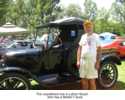
|

|
Thelen farm for sale added May 29, 2014, my sister sent ...
>> http://tours.patrickclancy.com/public/vtour/display/209341?a=1
> The [old Thelen] farm is up for sale.
> Relyea's , after 44 years there are moving to a condo.
> Thought you'd be interested in this. [sister] Reta
OH MY !!!!
The changes of time - this time in a positive way -
I'm so used to old abandoned farm homes, say on the plains,
sagging, unpainted, unloved,
falling to rack and ruin,
and me feeling sad - thinking of families long gone -
Here is an old farm home, clearly loved and not abandoned.
Well painted and cared for,
with lovely modern furniture -
They have even connected up to commercial electricity.
And the woods, which were filled with thorny wild raspberries,
and the ever present mosquitoes
have had the underbrush removed
and are now lovely parks.
I do kinda miss some of the old stuff -
- the big wood/coal stove/range in the kitchen
where you could heat water for Saturday night bath :-|
( bathing in galvanized steel wash tub )
and also heat irons for ironing shirts.
- the big black pot-bellied stove
in the living room
- old fashioned telephone with external carbon and steel lightning suppressors
in the living room - during lightning storms there would be snaps and sparks.
- clearly the windmill hasn't been used for years
- the sorta out-of-tune upright piano in the front room
(unless it is hidden in the big wooden cabinet ??)
- the big ugly tar paper covered wood shed by the south back door
where we had to get wood for the
- - kitchen range
- - pot bellied stove in living room
Some hits on Google -
over the years there have been multiple (fancy $400,000) homes added in
the woods east of the west 80 acres which required addresses
on the newly enhanced, extended, named "Thelen Farm Trail"
"our" farm seems to be at
1405 Thelen Farm Trail, Houlton, WI 54082
1405 Thelen Farm Trail, Houlton WI 54082, USA - Virtual Tour
tours.patrickclancy.com/209341?a=1
Virtual Tour of 1405 Thelen Farm Trail, Houlton WI 54082, USA.
http://www.mnseller.com/idx/mls-4485552-1405_thelen_farm_trail_houlton_wi_54082
|
Lonely - skunk tale - and years later from Mitch Allies - Oct 2015
|
Quick short story that happened in my early 12 year old days.
It was pretty lonely and boring on the farm by myself with parents that were 50 years my senior. One afternoon I was wandering on some of the sagebrush of the back 40, when I came upon a skunk with a few of her young offspring. I had heard they could throw their scent fluid through the air, but, this was most exciting thing the day had to offer so far, so I began to follow her through the brushy adobe landscape. I decided to get more aggressively close to see how she would react. In the end I picked up a squirt of her scent on my lower pantleg. So they have a range of maybe 5 or 6 feet. Mitch PS - completed my Corvette tour of the Great Sonoran Desert with a visit to one sister in Albuquereque, and another sister at the old farm in Montrose, Colo. It is getting harder for them to keep up with minimal farming activities in their early 80’s Dad’s old horse harnesses are still in the barn covered with a ton of dust and cobwebs. (I have had some thought of restoring one of them for souvenir or display purposes - problem being, how to display it.) So, to discover the process, I found a bridle that was easily detachable and brought it here. I spent some time during last two weeks - research - cleaning - de-orderize - recondition. Finally decided it was good enough as a learning example. I could probably do the whole harness in a reasonable amount of time. The real question is, what next after renovation is done? (my biggest discovery was that, for brightening iron rings and buckles, an abrasion wheel in a electric drill is much better that “naval Jelly”.) |
Telephone, and lightning - from Ed Thelen added Nov 2015

